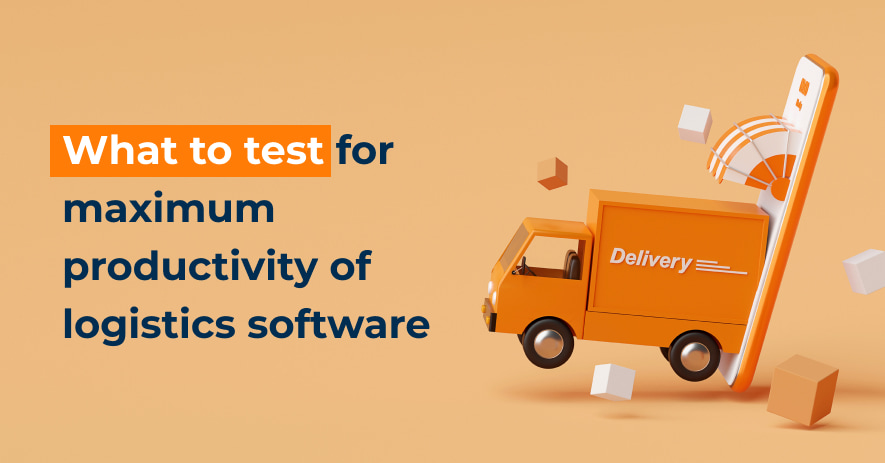- QATestLab Blog >
- QA for Business >
- Industries Insights >
- What to test for maximum productivity of logistics software
What to test for maximum productivity of logistics software

Logistics and supply chain software is in demand now, making lives easier all over the world. For such solutions to be really successful, though, they should meet the high quality standards and user expectations. And thorough testing is an important step in achieving that.
In this article, we write about the main aspects of logistics and supply chain apps that should be tested to achieve maximum productivity, users’ love, and overall success of this type of software.
Is the app fast and reliable?
While speed and reliability are important for any app, it is especially so in logistics and supply chain software. A slowly loading or constantly crashing solution can potentially cause delays in delivery. Logistics apps also usually need to display many real-time changes, so fast speed, quick loading, and stable performance are vital.
All these aspects and more can be checked with performance testing. It will help to make sure that the users can count on the app’s stable, reliable, and fast work under any conditions.
Can the app integrate with other systems with no issues?
Logistics software needs to integrate with many third-party solutions and systems to provide the users with a wide range of useful functionality. Logistics solutions should be checked as to how well they can connect with such systems, load information from them, and use the options these systems provide.
Does the app work well on different phones and devices?
Most logistics apps would have a mobile version as this type of software is often used on the move. There is a huge variety in screen resolutions, configurations, and characteristics of different phones and tablets. So an app may work well on some of them, but display and function incorrectly on others. This is why it is very important to check if a logistics solution is compatible with the devices its target audience will likely use.
Is it easy and convenient to use the app?
Logistics apps are usually complex solutions with much functionality. So it is especially important that they are designed and created in such a way that would not cause any confusion for users. The navigation, access to options, and the sequence of actions for every scenario when using the app should be clear, easy, and intuitive. So, to keep users happy with a logistics solution, it should be tested for ease of use and user-friendliness.
Does the order status change correctly online?
An issue that has a quick negative effect on a logistics app’s reputation and popularity among users is an incorrect change of status online. Some of the common problems this type of software should be checked for in this regard are: inability to monitor the goods’ inbound and outbound movement, no real-time updates, and inability to manage demurrage and detention problems.
Is the valid route logging ensured?
Route logging in logistics apps should be correct and complete as this functionality is among the ones users particularly appreciate. Some of the most common issues that can happen during route logging are the following: false route logs, incorrect information on the change of statuses, wrong data on the hauling of cargo, errors in the display of fuel, incorrect information on the driver’s activities, and others. To prevent such issues in the released application, it should be thoroughly checked beforehand.
Does tracking of cargo work correctly in real time?
Tracking of cargo in real time is one of the essential features logistics software may provide. So it is important to make sure it is working well. This functionality is enabled through a GPS tracker. If there are any issues with this feature, the exact moment of failure should be determined when checking to address the problem.
Can users with different rights access only the information they are allowed to?
In logistics and supply chain software, different roles, rights, and levels of access exist for users. So, when checking such applications, one needs to also test them for the following:
- if roles are assigned to users correctly;
- if the users have all the rights and access that are expected for their role;
- whether the users can access information and options that are restricted for their role.
These are important security concerns in logistics apps that can be checked with software testing.
Conclusion
Thorough checking of the aspects of logistics software described in this article will be a good contribution to making the solution thrive. But of course this is not an extensive list of what can be tested in this type of apps. Whether you check logistics solutions with the help of an in-house team, attract an independent vendor, or use the services of both, we wish you all the success.
If you need any assistance with software testing of your logistics app, our QA engineers have much experience in testing this type of solutions and will be ready to join your project anytime at any stage of software development. Please contact us.
Learn more from QATestLab
Related Posts:
- How to Deliver High-Quality Apps for Logistics?
- Automation Testing for Mobile Apps: Why It’s Essential and Our Key Services
- How One Bug Can Wreck Your Reputation — And How QA Prevents It
About Article Author
view more articles







No Comments Yet!
You can be the one to start a conversation.